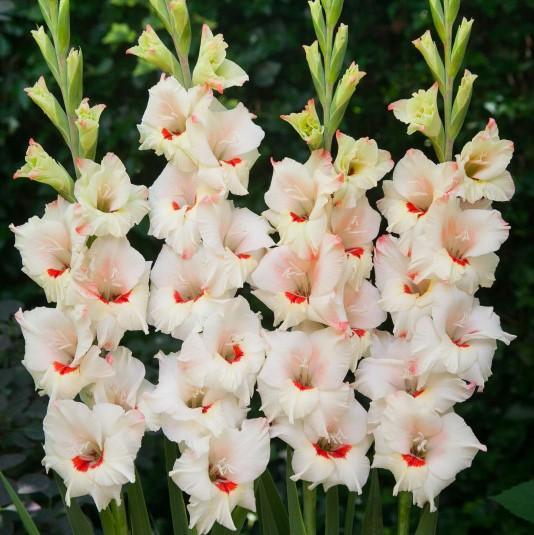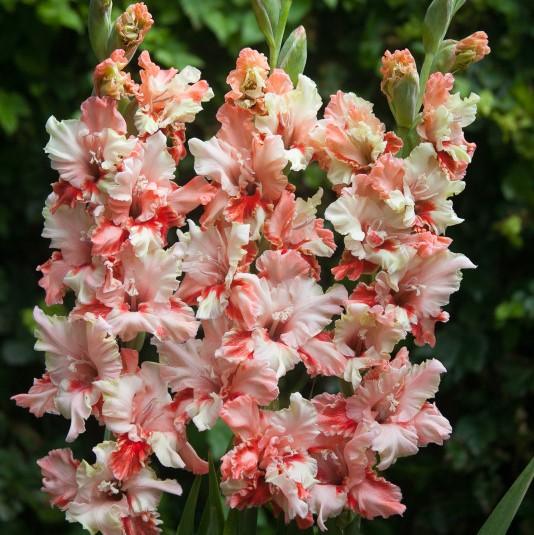Let’s Go Plant Some Glads—the Orchid of the Underclass
By Linda Lee

It’s not too late to plant great flowers. In fact, there are plenty you can still plant. So let’s go plant some gladiolus.
Don’t be turned off by some of the scary instructions.
“Plant after last frost?” How often do we read that instruction! Well, up north in 5b our last frost (26 degrees) was May 13. That’s the way things were before Global “Warming,” which is what they called it before they renamed it to “Climate Change.” Back then, you didn’t plant until Memorial Day. So here we are again.
Planting glads this late? No problem. Some people plant them every two weeks, for a constant crop in August and September. Glads are cheap, easy and, did I mention cheap? I call them the orchid of the underclass, but gladiolus fanciers – with their miniatures, their frilly Kirov hybrids, Abyssinian fragrant glads, hardy Nymphs (down to zone 4!) and species glads – would object to that.
Recommended: 10 Annuals for a Garden that Blooms All Summer
You can order bulbs that are still in stock online for $1 a bulb, like Frizzle Butterfly, pinkish Candy Bar, or red Vuelta from Easy to Grow Bulbs, plus shipping. Big box stores have bags of mixed colors, 25 bulbs – ok, they are actually CORMS – for about $13 at Home Depot, or at the same store the handsome purple Grande Passion bulbs, 12 for about $9 or a bag. Get started. You don’t have to plant them all at once.

Dig a hole about four inches deep. Drop in the corm, pointy side up. Fill in the hole. Your choice if you want a line of glads – a cutting garden – or perhaps a back wall for a flower bed. Glads can grow three feet tall. Most of these will not bloom for 80 to 90 days, depending on species. Do not plant them where you won’t be able to get to them without stepping on the pumpkins, zinnias, bedding plants or the children’s experimental garden.
They do need to be watered. Cut on the bias when a few flowers have opened. Pinch off dead flowers as they fade and recut the bottom of the stalk.
Colorful glads will be stunning in a bouquet that, let’s face it, in August, is going to need some colorful jazzing up until the dahlias come through.
Recommended: How to Grow and Care for Irises
The gladiolus is classified as part of the lily family, and native plants are found in South Africa, tropical African, Asia and Mediterranean Europe. Some of those native plants, like the Abyssinian, are sold today. Others were interbred by botanists all over the globe. (Gladiolus is named for the sword or “Gladioli” of the Romans, a name that represents the flat blade of the glad leaf, something children use in glad-leaf battles.)
It is lovely that the outer coat of a glad corm is called a “tunic,” because the mother of almost all hybridized glads planted is a species called Gladiolus dalenii, which grows wild from South Africa to western Arabia.
This species became a source for the modern glad because, and here we have to get scientific, it belongs to a genus that has diploid, tetraploid and hexaploidy races. Hybrids grown from Gladiolus dalenii often throw tetraploid offspring. In breeding circles, tetraploid is pure gold, because it allows for the most variations in offspring. Thus, all the frilly, speckled, bicolor, deep-colored, glads, and glads with throats of a different color, rouged cheeks, and embroidered edges.
They are a great flower to get to know and enjoy.
 Linda Lee is a former editor at The New York Times. She was the deputy editor of the House & Home section and wrote frequently for Sunday Styles.
Linda Lee is a former editor at The New York Times. She was the deputy editor of the House & Home section and wrote frequently for Sunday Styles.
